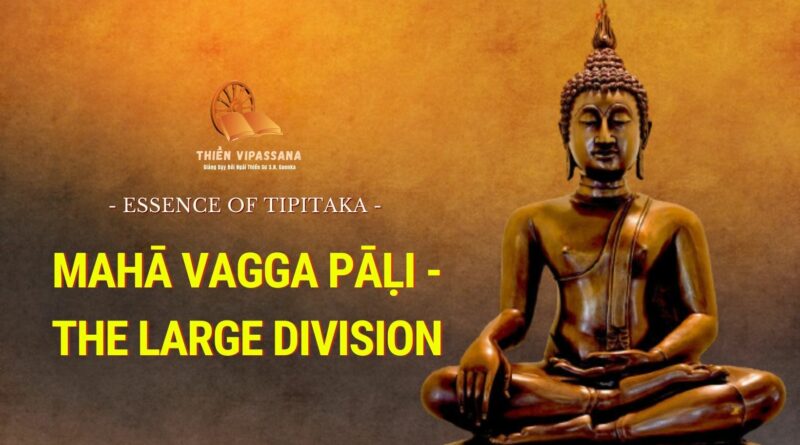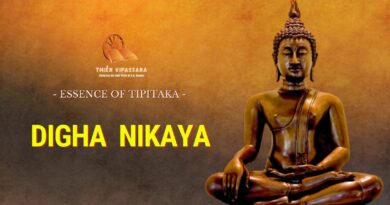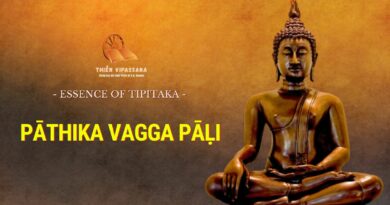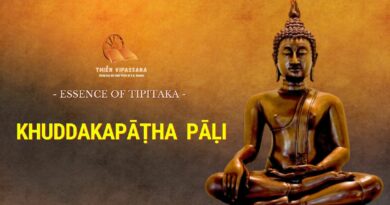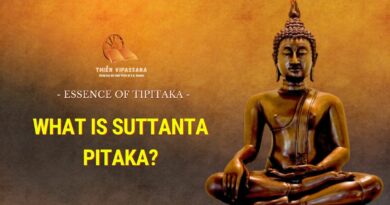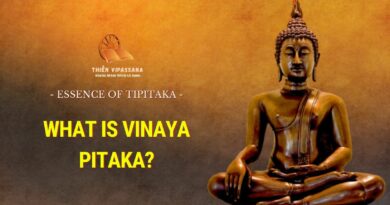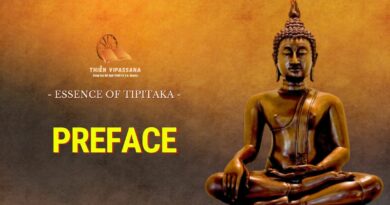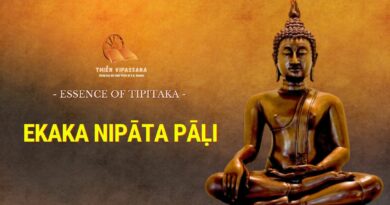2 Mahā Vagga Pāḷi-
The Large Division
The ten suttas in this division are some of the most important of the Tipiṭaka, dealing with historical and biographical aspects as well as the doctrinal aspects of Buddhism. The most famous sutta is the Mahāparinibbāna Sutta which gives an account of the last days and the passing away of the Buddha and the distribution of his relics. Mahāpadāna Sutta deals with brief accounts of the last seven Buddhas and the life story of the Vipassī Buddha. Doctrinally important are the two suttas: the Mahānidāna Sutta, which explains the Chain of Cause and Effect, and the Mahāsatipaṭṭhāna Sutta, which deals with the four methods of steadfast mindfulness and practical aspects of Buddhist meditation.
Mahāpadāna Sutta
This discourse was given at Sāvatthi to the bhikkhus who were one day discussing the Buddha’s knowledge of past existences. He told them about the last seven Buddhas, with a full life story of one of them, the Vipassī Buddha, recalling all the facts of the Buddhas, their social rank, name, clan, life-span, the pairs of chief disciples, the assemblies of their followers, their attainments, and emancipation from defilements.
The Buddha explained that his ability to remember and recall all the facts of past existences was due to his own penetrating discernment as well as due to the devas making these matters known to him.
Mahānidāna Sutta
This discourse was given at Kammāsadhamma market town to the Venerable Ānanda to correct his wrong view that the doctrine of Paṭiccasamuppāda, although having signs of being deep and profound, was apparent and fathomable. The Buddha told him that this doctrine not only appeared to be deep and profound but was actually deep and profound on four counts: it was deep in meaning, deep as a doctrine, deep with respect to the manner in which it was taught, and deep with regard to the facts on which it was established.
He then gave a thorough exposition on the doctrine and said that because of lack of proper understanding and penetrative comprehension of this doctrine, beings were caught in and unable to escape from the ruinous round of rebirth. He concluded that without a clear understanding of this doctrine, even the mind of those accomplished in the attainments of jhāna would be clouded with ideas of atta.
Mahāparinibbāna Sutta
This sutta is an important narrative of the Buddha’s last days, a detailed chronicle of what he did, what he said and what happened to him during the last year of his life. Compiled in a narrative form, it is interspersed with many discourses on some of the most fundamental and important aspects of the Buddha’s teaching. Being the longest discourse of the Dīgha Nikāya, it is divided into six chapters.
On the eve of the last great tour, the Buddha, while staying at Rājagaha, gave the famous discourses on seven factors of non-decline of kings and princes, and seven factors of non-decline of bhikkhus.
Then he set out on his last journey going first to the village of Pāṭali where he taught on the consequences of an immoral and a moral life. He then proceeded to the village of Koṭi where he expounded on the Four Noble Truths. Then the Buddha took up his residence at the village of Nātika where the famous “Discourse on the Mirror of Truth” was given.
Next the Buddha went to Vesāli with a large company of bhikkhus. At Vesāli he accepted the park offered by the courtesan Ambapāḷi. From Vesāli, the Buddha travelled to a small village named Veluva where he was overtaken by a severe illness that could have proved fatal. But the Buddha resolved to maintain the life-process and not to pass away without addressing his lay disciples and without taking leave of the Sangha. When Ānanda informed the Buddha how worried he had been because of the Buddha’s illness, the Buddha gave the famous injunction: “Let yourselves be your own support, your own refuge. Let the Dhamma, not anything else, be your refuge.”
It was at Vesāli that the Buddha made the decision to pass away and realize parinibbāna in three months’ time. Upon his making this momentous decision there was a great earthquake. Ānanda, on learning from the Buddha the reason of the earthquake, supplicated him to change the decision, but to no avail.
The Buddha then caused the Sangha to be assembled to whom he announced his approaching parinibbāna. He then went over all the fundamental principles of his teaching and exhorted them to be vigilant, alert, and to watch over their own mind so as to make an end of suffering.
The Buddha then left Vesāli and went to Bhaṇḍa village where he continued to give his discourses to the accompanying Sangha on sīla, samādhi and paññā. Proceeding further on his journey to the north, he gave the discourse on the four great authorities (mahāpadesa) at the town of Bhoga.
From there he went on to Pāvā and stayed in the Mango Grove of Cunda, the Goldsmith’s son, who made an offering of food to the Buddha and his community of bhikkhus. After eating the meal offered by Cunda, a severe illness came upon the Buddha who nevertheless continued on his journey until he reached Kusinārā where in the Sal Grove of the Malla princes he urged Ānanda to lay out the couch for him. He lay down on the couch with mindfulness and deliberation, awaiting the hour of his parinibbāna.
Even on his death-bed the Buddha continued to teach; he explained that there are four places which arouse reverence and devotion and four persons worthy of a stupa; and he answered Ānanda’s questions on how to conduct oneself with regard to women, and on what should be done regarding the remains of the Buddha. His last act of selflessness was to expound the truth and show the path to Subhadda, the wandering ascetic.
Then after ascertaining that there was not a single bhikkhu who had perplexity or doubt about the Buddha, the Dhamma and the Sangha, the Buddha uttered his last words: “Inherent in all compounded things is decay and dissolution. Strive well with full mindfulness.”
Then as the assembled bhikkhus, princes and people paid homage to him with deep reverence, the Buddha passed away, realizing parinibbāna.
Mahāsudassana Sutta
This discourse was given by the Buddha while he was lying on his death-bed in the Sal Grove of the Mallas. When Ānanda implored him not to realize parinibbāna in an insignificant, barren, small town, the Buddha told him that Kusinārā was not an insignificant small place. In times long past, it was known as Kusāvatī, the capital city of universal monarchs who ruled over the four quarters of the world.
The Buddha then described the magnificence and grandeur of Kusāvatī when King Mahāsudassana was the ruler there. He also told how the King ruled over his dominions righteously and how finally abandoning all attachments and practising jhāna he passed away and reached the blissful Brahmā realm.
The Buddha revealed that he himself was King Mahāsudassana of that time. He had cast off the body in this place (former Kusāvatī) six times as a universal monarch. Now he was casting it off for the seventh and last time. He ended the discourse reminding Ānanda that all compounded things are indeed impermanent. Arising and decaying are their inherent nature. Only their ultimate cessation is blissful nibbāna.
Janavasabha Sutta
This discourse is an extension of another discourse delivered by the Buddha on his last journey. Ānanda wanted to know the destinies of lay disciples from the country of Magadha. The Buddha told him that innumerable persons from Magadha had reached the deva world by virtue of their faith in the Buddha, the Dhamma and the Sangha. This information was given him by Janavasabha Deva who was formerly King Bimbisāra. He informed the Buddha that there were regular assemblies of devas in the deva realm on uposatha days when the king of the devas and Sanaṅkumāra Brahmā taught the Dhamma on development of the bases of psychic power, on the three opportunities, on the four methods of steadfast mindfulness and the seven accessories of concentration.
Mahāgovinda Sutta
In this discourse, Pañcasikha, a gandhabba deva, told the deva assembly where Sanaṅkumāra Brahmā taught the Dhamma as shown by Mahāgovinda, the bodhisatta who had reached the Brahmā world. The Buddha said that Mahāgovinda was none other than himself and explained that the Dhamma he taught at that time could lead one only to the Brahmā world. With his teaching now as an enlightened Buddha, higher attainments such as the sotāpatti, anāgāmi and the highest achievement arahatta phala were possible.
Mahāsamaya Sutta
The Buddha was residing in the Mahāvana forest at Kapilavatthu with a company of arahats numbering five hundred. Then devas and Brahmās from ten thousand cakkavāḷas came to see the Buddha and the community of bhikkhus. The Buddha told his disciples the names of the devas and Brahmās as listed in this sutta.
Sakkapañha Sutta
Once when the Buddha was residing at the Indasāla Cave near Rājagaha, Sakka, the king of devas, came to him to ask certain questions. He wanted to know why there was hostility and violence among various beings. The Buddha told him it was envy and selfishness that brought about hostility among beings. He further explained that envy and selfishness were caused by likes and dislikes, which in turn had their roots in desire. And desire grew from mental preoccupation (vitakka) which had its origin in saṃsāra-expanding illusions (papañca-saññā-saṅkha).
The Buddha then gave an outline of practices to remove thesesaṃsāra-expanding illusions including two types of quests, quests that should be pursued and quests that should not be pursued.
Mahāsatipaṭṭhāna Sutta
This sutta is one of the most important doctrinal discourses of the Buddha. It propounds the only way for the purification of beings, for overcoming sorrow and lamentation, for the complete removal of pain and grief, for the attainment of the right path, and for the realization of nibbāna. This discourse, given directly to the bhikkhus at the market town of Kammāsadhamma, defines “the only way” as the four methods of steadfast mindfulness made up of fourteen ways of contemplating the body, nine ways of contemplating sensation, sixteen ways of contemplating the mind, and five ways of contemplating the Dhamma. It ends with a definite assurance of fruitful results: arahatship in this very existence or the state of an anāgāmi within seven years, seven months or seven days.
Pāyāsi Sutta
This discourse recounts how the Venerable Kumārakassapa showed the right path to Governor Pāyāsi of Setabyā town in Kosala country. Governor Pāyāsi held the wrong belief: “There is no other world; no beings arise again after death; there are no consequences of good or bad deeds.” The Venerable Kumārakassapa showed him the right path, illustrating his teaching with numerous illuminating similes. Ultimately Pāyāsi became full of faith and took refuge in the Buddha, the Dhamma and the Sangha. The Venerable Kumārakassapa taught him also the right kind of offerings to be made and that these offerings would be made with due respect, by one’s own hands, with due esteem and not as if discarding them. Only under these conditions would the good deed of offerings bear splendid fruits.

